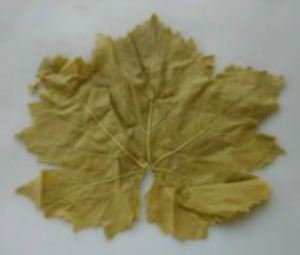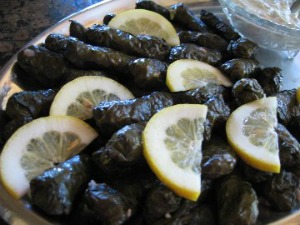Fresh Whole Grape Leaves:
 Fresh grape leaves are best picked from grape vines in the late Spring and early Summer (May and June), while they are still tender and unsprayed. Also try to pick the grape leaves early in the day. During this time period, no grapes are visible on the grape vines.
Fresh grape leaves are best picked from grape vines in the late Spring and early Summer (May and June), while they are still tender and unsprayed. Also try to pick the grape leaves early in the day. During this time period, no grapes are visible on the grape vines.
Be sure and pick the grape leaves before the first spray as some sprays are toxic. Most of the spays used today are non-toxic and water soluble, but sulfur taste is not what you want on your grapes.
Select young whole, medium-size leaves (4- to 5-inches wide) with a good light green color and no holes (too small grape leaves will tear when using and too large grape leave are tough and chewy). The leaves should also be shiny, smooth leaves. Avoid fuzzy thick leaves.
The best leaves are those below the new growth at the top of the grape plant. The grape leaves thicken and toughen as the sun ages them.
Rule of thumb – count down three (3) leaves from the new growth at the end of the vine, and pick the next 2 to 3 leaves, then move on to the next stem.
Pick approximately 1 1/2 pounds of fresh leaves. 1 to 1 1/2 pounds of small fresh leaves = approximately 100 to 120 leaves.
Thoroughly rinse the grapes leaves in cold water and then drain.
Using a sharp knife or scissors, cut off the stems.
Blanch the Grape Leaves: Fresh grape leaves should be blanched before using. Either soak in very hot water for 15 minutes to soften the leaves or blanch grape leaves in a brine until they are soft (the time will depend on the leaves – fresh ones will only take a minute).
Brine Recipe:
4 cups water
1 cup salt
Bring water to and boil. Add grape leave, approximately 12 leave at a time. Bring water just back to a boil; remove grape leaves immediately and plunge the leave into ice water. Drain and dry the leave with paper towels. NOTE: By doing this step it helps to set the color in the leaves.
Store leaves between layers of paper towels in air-tight resealable plastic bags and freeze until ready to use.
To Use: Use as soon as you thaw them as they do not keep too well after freezing. Frozen grape leaves only last about 6 months in the freezer.
Recipes using fresh or bottled grape leaves:

Dolmades (Stuffed Grape Leaves)
Often served as part of a meze (appetizer) plate. Too often they come from a can and are not fresh. Homemade are far superior to the canned. If you have never tried fresh dolmades, now is the time. They are very easy to make and so delicious!
Egyptian Stuffed Grape Leaves Recipe
This is a traditional Egyptian Stuffed Grape Leaves recipe shared with What’s Cooking America by Chef Maha Barsoom. Maha is a personal chef and caterer specializing in Egyptian cooking. Maha travels all over North America and Europe teaching about Egyptian cooking and cuisine.
Stuffed Grape Leaves with Gorgonzola and Olives
These wonderful appetizers are great to serve with wine and cheese!

9 Responses to “Using Fresh Grape Leaves”
Richard Nero
Can you tell me were to buy fresh grapes leaves? They must have to come from an ethnic specialty store, the local stores by me only have bottled leaves and I’m not certain they are going to work in my pickling jars to provide tannins for crunchy pickles.
Thanks,
Whats Cooking America
I’m not sure what area you live, but you might have luck buying fresh grape leaves from a winery during the summer months, or you could grow your own grape vines for leaves then preserve them yourself for the winter months. Pick the freshly sprouted leaves from unsprayed vines.
Glen Tapanila
I get grape leaves and pine nuts from Amazon. Orlando Grape Leaves are hard to find in Hawaii, so Amazon is my best bet. The ones I’ve gotten from the stores here tend to be small. I like bigger ones – you can put more stuffing in them.
Sana
I boiled the water and salt added the grape leaves and its smells like rotten eggs are they bad should we not eat them they tast normal just the smell from boiling them it’s stunk the house any advice?
Linda Stradley
I, personally, have not used the fresh grape leaves. If they smelled that bad, I would probably “toss them.”
Bert
Would someone tell what grape leaves taste like?
As cabbage rolls are kind of nasty, to me. Green beans are nasty when all soft and slimy. But some cool where they’re crisp in a tomatoe based base with good things like onion, pepper, garlic, etc.
Do grape leaves have a green taste, a woody taste, what can it be compared to?
I think middle ea Steelers are big on grape leaves. Where I’m the south, many foods are foods that were necessary to get by on, which some were good, some simply part of a culture passed down.
So we’re grape leaves really good by themselves or was it something to bulk up the meal?
Someone learn me something please.
How can they be stored in a brine rather than a freezer?
John Jacob
Grape leaves taste like mild collard greens but way less strong. They can be a little stringy if too old or not cooked long enought. I understand they make a good salad too but have not tried it. The best way to store them is in brine. I have not tried or heard of freezing them but I’m sure you can. When you cook them make sure you keep our stock acid with either wine or tomatotes (or both).
Tony L
The rotten egg smell is from Hydrogen Sulfide which probably came from natural causes of either soil, rock, water reaction or Sulfur producing Bacteria. Most likely this water was absorbed the the vine but possibly from the water you boiled the leaves in.
Stas
Grape vines are frequently sprayed with sulfur compounds to keep them healthy and keep the fungus away. However, this means the leaves will retain some of that sulfur and when you try to cook them , sulfur will manifest itself as a nasty smell of rotten eggs (hydrogen sulfide, mostly). Not very appetizing though you can wait and see if the smell dissipates shortly. Almost all sulfur compounds are stinky but also very volatile and the important thing to remember is that while the smell is gross, the actual amount of sulfur causing it is extremely tiny – it’s just that humans are extraordinarily sensitive to it detecting even as minute amount as 1 part of hydrogen sulfide per million.